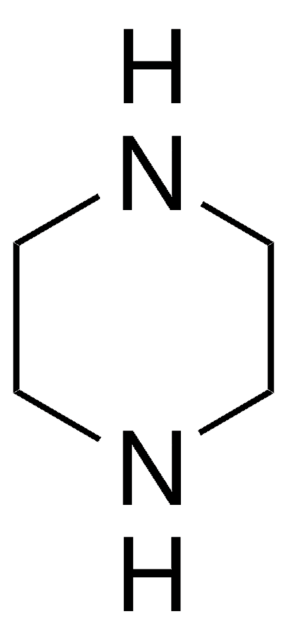Wichtige Dokumente
571261
Piperidin
biotech. grade, ≥99.5%
Synonym(e):
Hexahydropyridin
About This Item
106 °C
Empfohlene Produkte
Qualität
biotech. grade
Qualitätsniveau
Dampfdichte
3 (vs air)
Dampfdruck
23 mmHg ( 20 °C)
Assay
≥99.5%
Form
liquid
Methode(n)
DNA sequencing: suitable
Verunreinigungen
<0.3% water
Brechungsindex
n20/D 1.452 (lit.)
bp
106 °C (lit.)
106 °C
mp (Schmelzpunkt)
−13 °C (lit.)
Löslichkeit
organic solvents: soluble(lit.)
water: miscible(lit.)
Dichte
0.862 g/mL at 20 °C (lit.)
λ
1 cm path, H2O reference
UV-Absorption
λ: 290 Amax: <1.000
λ: 370 Amax: <0.050
SMILES String
C1CCNCC1
InChI
1S/C5H11N/c1-2-4-6-5-3-1/h6H,1-5H2
InChIKey
NQRYJNQNLNOLGT-UHFFFAOYSA-N
Suchen Sie nach ähnlichen Produkten? Aufrufen Leitfaden zum Produktvergleich
Allgemeine Beschreibung
Anwendung
Signalwort
Danger
H-Sätze
Gefahreneinstufungen
Acute Tox. 3 Dermal - Acute Tox. 3 Inhalation - Acute Tox. 4 Oral - Eye Dam. 1 - Flam. Liq. 2 - Skin Corr. 1B
Lagerklassenschlüssel
3 - Flammable liquids
WGK
WGK 1
Flammpunkt (°F)
60.8 °F - closed cup
Flammpunkt (°C)
16 °C - closed cup
Hier finden Sie alle aktuellen Versionen:
Analysenzertifikate (COA)
Die passende Version wird nicht angezeigt?
Wenn Sie eine bestimmte Version benötigen, können Sie anhand der Lot- oder Chargennummer nach einem spezifischen Zertifikat suchen.
Besitzen Sie dieses Produkt bereits?
In der Dokumentenbibliothek finden Sie die Dokumentation zu den Produkten, die Sie kürzlich erworben haben.
Kunden haben sich ebenfalls angesehen
Unser Team von Wissenschaftlern verfügt über Erfahrung in allen Forschungsbereichen einschließlich Life Science, Materialwissenschaften, chemischer Synthese, Chromatographie, Analytik und vielen mehr..
Setzen Sie sich mit dem technischen Dienst in Verbindung.










